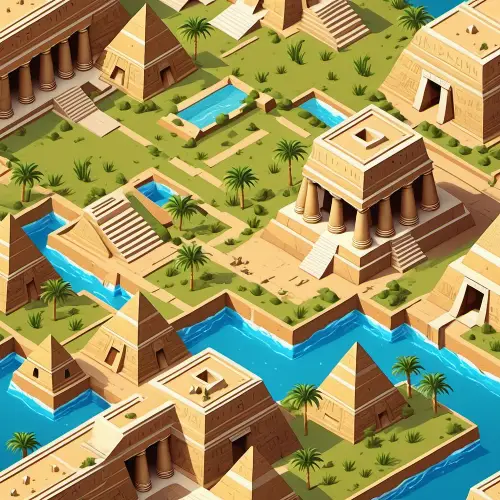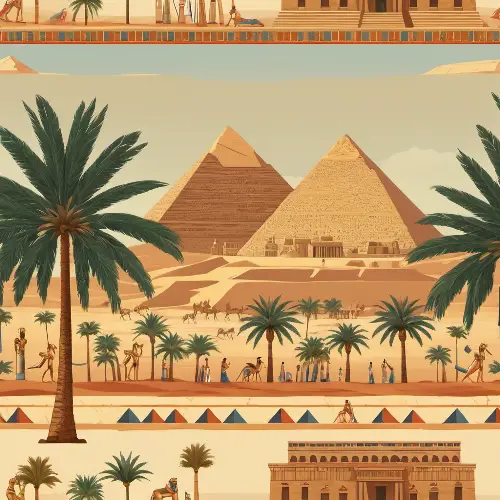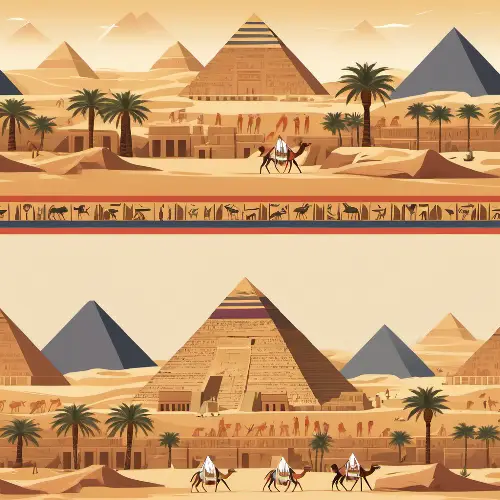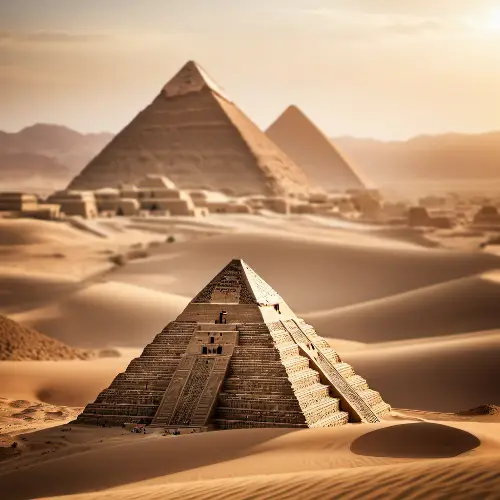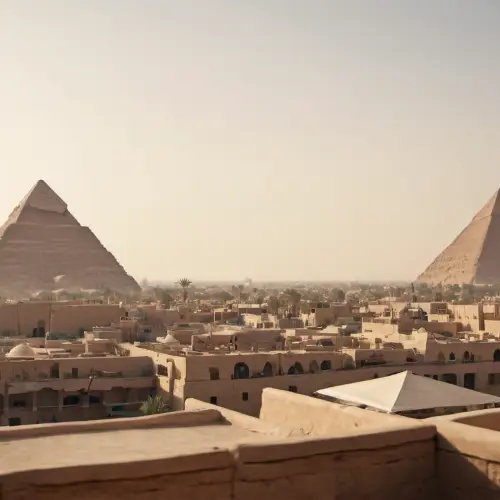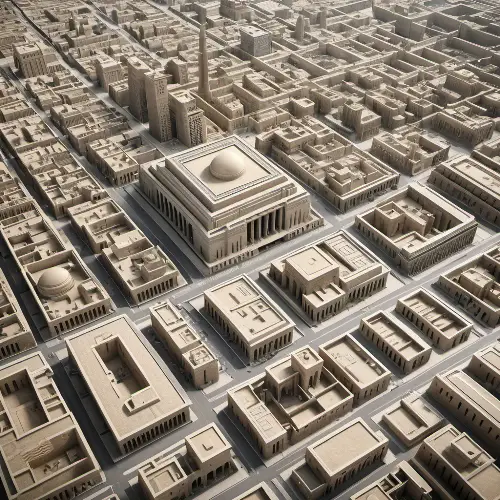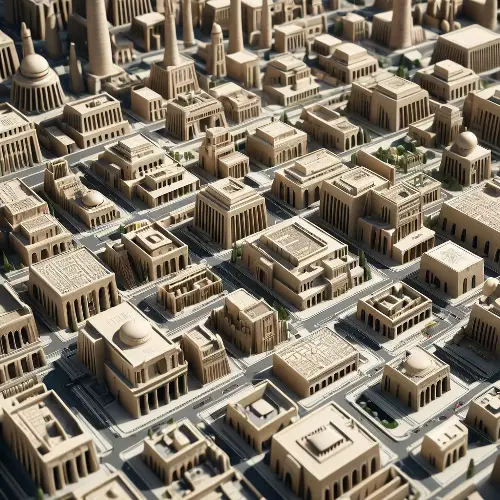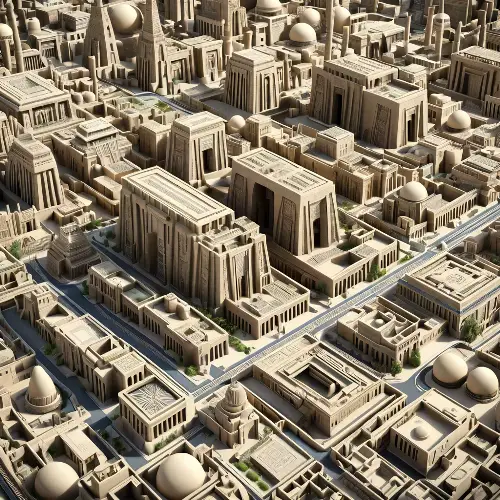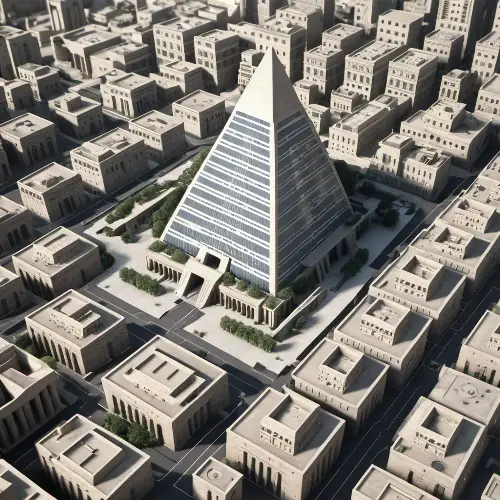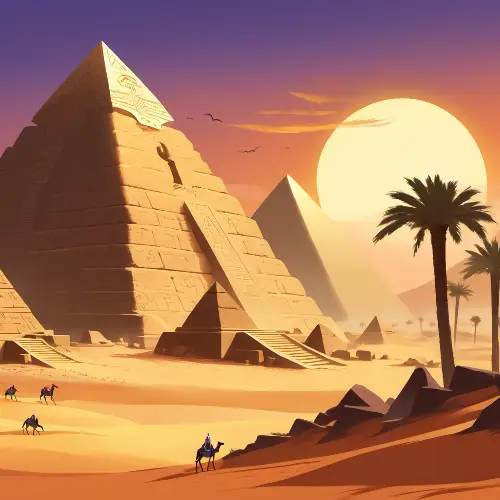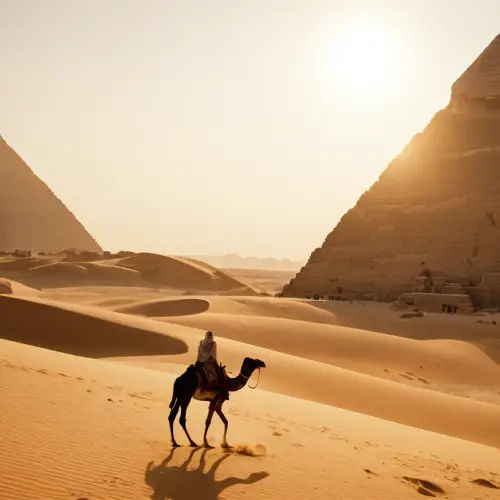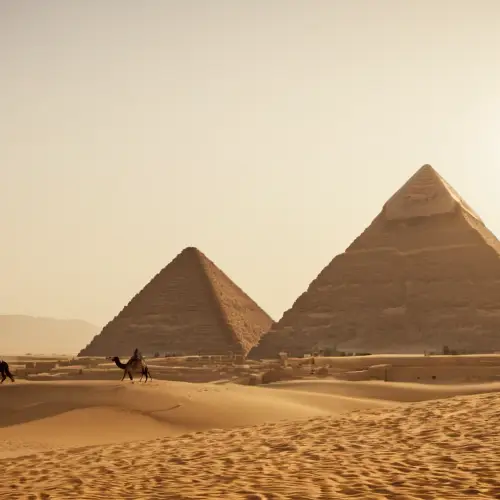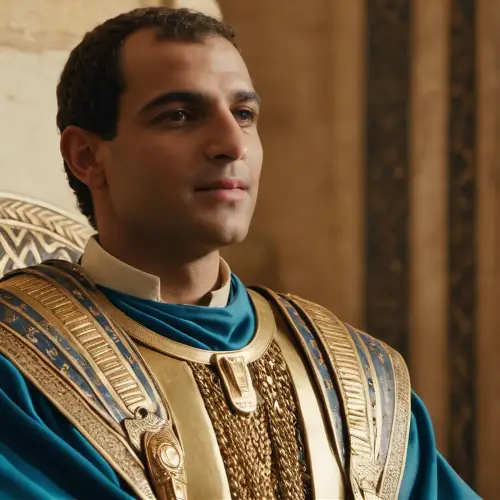ancient Egyptian architecture civilization passed through multiple periods, and the Pharaonic families inherited the rule of Egypt, the progression and perspective in the art of architecture, including palaces, temples, and tombs from the era of Nefertari, Ahmose, Amun, Akhenaten, Rasmis II, the Temple of Hatshepsut, Cleopatra’s palaces, and the pyramids, the proportion and Proportion, birds eye perspective, the moment of sunset
More Like This
Ancient Egyptian architecture building features post and lintel construction, massive walls with hieroglyphic carvings, flat roofs, and structures like mastaba, obelisk, pylon, and pyramids. The facades use large columns, stone, hieroglyphs, and colors. The floor is alabaster, and the roof is supported by red granite pillars. The architecture also features pylon gateways, hypostyle halls, obelisks, and hieroglyphic decorations.
Ancient Egyptian architecture building features post and lintel construction, massive walls with hieroglyphic carvings, flat roofs, and structures like mastaba, obelisk, pylon, and pyramids. The facades use large columns, stone, hieroglyphs, and colors. The floor is alabaster, and the roof is supported by red granite pillars. The architecture also features pylon gateways, hypostyle halls, obelisks, and hieroglyphic decorations.
Ancient Egyptian civilization featured architecture, pyramids, temples, and decorations by pharaohs. Sunsets, Nile, falcons in the sky, and the cat god were significant aspects of their culture.
Ancient Egyptian civilization featured architecture, pyramids, temples, and decorations by pharaohs. Sunsets, Nile, falcons in the sky, and the cat god were significant aspects of their culture.
Ancient Egyptian civilization featured architecture, pyramids, temples, and decorations by pharaohs. Sunsets, Nile, falcons in the sky, and the cat god were significant aspects of their culture.
Ancient Egyptian civilization featured architecture, pyramids, temples, and decorations by pharaohs. Sunsets, Nile, falcons in the sky, and the cat god were significant aspects of their culture.
Ancient Egyptian civilization featured architecture, pyramids, temples, and decorations by pharaohs. Sunsets, Nile, falcons in the sky, and the cat god were significant aspects of their culture.
Ancient Egyptian architecture featured a sunset sky scene with a granite temple with a T-shaped hall, alabaster floor, and red granite pillars. The mortuary temple had a central open court, storerooms, shrines connected to monarchs, and a chapel.
Ancient Egyptian architecture featured a sunset sky scene with a building
In the heart of Alexandria, Cleopatra stands amidst a construction site, adorned in regal attire with architectural plans in hand. Skilled artisans and builders, inspired by her vision, work tirelessly on monumental structures that blend Egyptian and Hellenistic influences.The air resonates with the sounds of chisels and hammers against stone, creating a symphony of progress. Columns rise, adorned with intricate carvings, and grand archways take shape, symbolizing the synthesis of cultures under Cleopatras reign. The scene captures the queens commitment to architectural innovation, as ancient and contemporary elements come together to shape a new era for Egypt.
In the heart of Alexandria, Cleopatra stands amidst a construction site, adorned in regal attire with architectural plans in hand. Skilled artisans and builders, inspired by her vision, work tirelessly on monumental structures that blend Egyptian and Hellenistic influences.The air resonates with the sounds of chisels and hammers against stone, creating a symphony of progress. Columns rise, adorned with intricate carvings, and grand archways take shape, symbolizing the synthesis of cultures under Cleopatras reign. The scene captures the queens commitment to architectural innovation, as ancient and contemporary elements come together to shape a new era for Egypt.
In the heart of Alexandria, Cleopatra stands amidst a construction site, adorned in regal attire with architectural plans in hand. Skilled artisans and builders, inspired by her vision, work tirelessly on monumental structures that blend Egyptian and Hellenistic influences.The air resonates with the sounds of chisels and hammers against stone, creating a symphony of progress. Columns rise, adorned with intricate carvings, and grand archways take shape, symbolizing the synthesis of cultures under Cleopatras reign. The scene captures the queens commitment to architectural innovation, as ancient and contemporary elements come together to shape a new era for Egypt.
Architecture building of Karnak Temples are distinguished by their strength, luxury, and beauty, due to the use of huge stones in the high construction of walls, columns, obelisks, bridges, statues, and aesthetic elements in the proportions of construction, engraving, sculpture, drawing, and colors on the stones, in addition to the precision in making the lighting openings, most notably the openings. Through which the suns rays pass and perpendicular to the Holy of Holies.
Exterior walls, columns, and piers, were covered with hieroglyphic and pictorial frescoes and carvings painted in brilliant colors. motifs of Egyptian ornamentation are symbolic, such as the scarab, or sacred beetle, the solar disk, and the vulture. motifs include palm leaves, the papyrus plant, and the buds and flowers of the lotus. Hieroglyphs were inscribed for decorative purposes as well as to record historic events or spells. In addition, these pictorial frescoes and carvings how the Ancient Egyptians lived, their statuses, the wars that were fought, and their beliefs. Temples adjoined to the pyramids of Giza. , fog sky, sunset, birds-eye perspective., river , desert
buildings facade of the Exterior walls, columns, and piers, were covered with hieroglyphic and pictorial frescoes and carvings painted in brilliant colors. motifs of Egyptian ornamentation are symbolic, such as the scarab, or sacred beetle, the solar disk, and the vulture. motifs include palm leaves, the papyrus plant, and the buds and flowers of the lotus. Hieroglyphs were inscribed for decorative purposes as well as to record historic events or spells. In addition, these pictorial frescoes and carvings how the Ancient Egyptians lived, their statuses, the wars that were fought, and their beliefs. Temples adjoined to the pyramids of Giza. , fog sky, sunset, birds-eye perspective., river, desert
The majestic construction of the Great Pyramid of Pharaoh Tutankhamun unfolds in ancient Egypt. Towering and massive, the pyramid's smooth limestone blocks are meticulously stacked. Workers, adorned in traditional Egyptian garments, skillfully haul and place the heavy stones. The desert setting is bathed in a warm, golden glow from the sun. The intricate architecture reflects the mastery of ancient Egyptian craftsmanship, creating an awe-inspiring and grand atmosphere.
layout of Architecture building of Karnak Temples are distinguished by their strength, luxury, and beauty, due to the use of huge stones in the high construction of walls, columns, obelisks, bridges, statues, and aesthetic elements in the proportions of construction, engraving, sculpture, drawing, and colors on the stones, in addition to the precision in making the lighting openings, most notably the openings. Through which the suns rays pass and perpendicular to the Holy of Holies.
Cleopatra, adorned in regal attire, walks through a bustling construction site in the heart of Alexandria. Surrounded by architects and craftsmen, she inspects the progress of a grand edifice taking shape. Dust fills the air as skilled artisans meticulously carve intricate details into stone, bringing her architectural vision to life.The backdrop is a blend of ancient Egyptian motifs and Hellenistic design, reflecting Cleopatras commitment to a harmonious synthesis. The rhythmic sounds of construction echo through the air, and the queen, with a keen eye, offers guidance to ensure the realization of her ambitious architectural endeavor.
The ancient Greek Architecture style of temple building facades includes large stone works or stone structures, symmetry, square or rectangular floor plans, praticoes , uniformity, simplicity, proportions and harmony, tall, classic columns, and a row of columns along the façade with decorative details of bronze or gold color, \u0026 sophisticated sculptures on slopped roofs, Around the temple building is a city and at the center of it Agora the central meeting place, and settlements around it and statues for a cult god with the stunning sunrise sky, White-tipped doves on the ground
The ancient Greek Architecture style of temple building facades includes large stone works or stone structures, symmetry, square or rectangular floor plans, praticoes , uniformity, simplicity, proportions and harmony, tall, classic columns, and a row of columns along the façade with decorative details of bronze or gold color, \u0026 sophisticated sculptures on slopped roofs, Around the temple building is a city and at the center of it Agora the central meeting place, and settlements around it and statues for a cult god with the stunning sunrise sky, White-tipped doves on the ground
Within the expansive halls of Cleopatras palace, the queen passionately addresses a diverse gathering of scholars, architects, priests, and merchants. Adorned in garments that blend Egyptian and Hellenistic influences, Cleopatra articulates her vision for comprehensive reforms across agriculture, commerce, architecture, and religion.The scene unfolds against the backdrop of an ancient Egyptian setting, with symbols of fertility, trade, and spirituality adorning the surroundings. Maps and architectural plans are spread across tables, illustrating Cleopatras forward-thinking initiatives. The ambiance is one of intellectual exchange and collaboration, symbolizing the queens commitment to advancing her kingdom across multiple domains.
A panoramic view of an Egyptian cityscape with the majestic pyramids in the background.
the architectural layout of the technological city influenced by modern ancient Egyptian architecture
the architectural layout of the technological city influenced by modern ancient Egyptian architecture
luxury, the rich building facade of the Exterior walls massive stones, columns, and piers, were covered with hieroglyphic and pictorial frescoes and carvings painted in brilliant colors. motifs of Egyptian ornamentation are symbolic, such as the scarab, or sacred beetle, the solar disk, and the vulture. motifs include palm leaves, the papyrus plant, and the buds and flowers of the lotus. Hieroglyphs were inscribed for decorative purposes as well as to record historic events or spells. In addition, these pictorial frescoes and carvings how the Ancient Egyptians lived, their statuses, the wars that were fought, and their beliefs. Temples adjoined to the pyramids of Giza. , fog sky, sunset sky moment, birds-eye perspective., river, desert, bridging
Capturing the mysterious essence of Egypt, the scene unfolds with vast, golden deserts stretching to the horizon, where ancient pyramids rise like colossal sentinels under the shimmering sun. The air is filled with whispers of time, carrying tales of pharaohs, hidden chambers, and the enigmatic Sphinx, casting an aura of mystique over the timeless land.
In the vibrant spring of 51 BCE, bathed in the warm glow of sunlight, the young Ptolemy XIII assumes his fathers mantle as the Pharaoh of Egypt. His face, a mixture of youthful innocence and the weight of responsibility, reveals the essence of a burgeoning leader.Seated beside him on the throne, Cleopatra, his sister and co-ruler, the epitome of regal grace, signifies unity and strength. Their marriage becomes a symbol of power and consolidation, promising to guide Egypts destiny hand in hand. The scene encapsulates the tender moment of an alliance, where two hearts, still in their formative years, pledge to grow together.
Vast desert sands stretch as far as the eye can see, enveloping the banks of the Nile river in a golden haze. Upon the water glide ornate wooden vessels, their painted sails catching the northern breeze as oarsmen guide their way. Along the shore, figures toil - harvesting grain, drawing water, crafting wares under the watchful gaze of the Sphinx. All pay tribute to the great kings who granted this verdant strip of civilization. And towering above the dusty villages, the stepping stones of Giza jut proudly into the sky, a monument to past rulers and a reminder of Egypt's eternal nature. It is here in this timeless landscape that Pharaoh Tutankhamun reigns, overseeing an empire that has endured for millennia.
Anubis,detailed,god,ancient Egypt style,highly detailed,stunning architecture,by Mark Demsteader
Anubis,detailed,god,ancient Egypt style,highly detailed,stunning architecture,by Mark Demsteader
Anubis,detailed,god,ancient Egypt style,highly detailed,stunning architecture,by Mark Demsteader
Anubis,detailed,god,ancient Egypt style,highly detailed,stunning architecture,by Mark Demsteader
Anubis,detailed,god,ancient Egypt style,highly detailed,stunning architecture,by Mark Demsteader









































